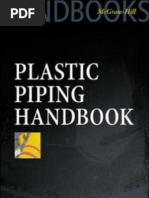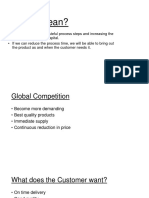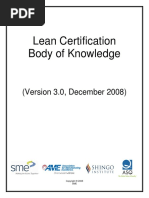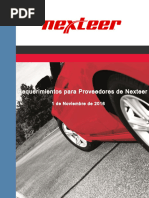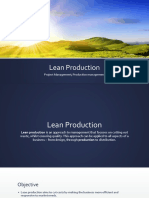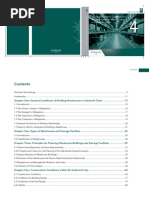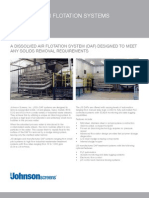Lean MFG - Gold
Lean MFG - Gold
Uploaded by
pragthedogCopyright:
Available Formats
Lean MFG - Gold
Lean MFG - Gold
Uploaded by
pragthedogOriginal Title
Copyright
Available Formats
Share this document
Did you find this document useful?
Is this content inappropriate?
Copyright:
Available Formats
Lean MFG - Gold
Lean MFG - Gold
Uploaded by
pragthedogCopyright:
Available Formats
82
K. Chandrasekaran
completed his
Bachelor of
Technology
(Mechanical) from
IIT Madras, and
Post Graduate
Diploma in industrial
management from
University of Mumbai.
He has over 40
years of experience
in manufacturing,
general management
and consultancy and
has been with RSM
Astute Consulting for
over 14 years.
Lean Manufacturing
Techniques In
Jewellery Industry
S
everal techniques and
models may be adopted
to address issues related
to productivity and
competitiveness. One
such popular set of tools is known as
Lean Manufacturing Techniques.
Te aim of the article is also to
provide an introduction to the Lean
Manufacturing Competitiveness
Scheme promoted by the Government
of India that can be made use of by
the organisations in the jewellery
manufacturing industry.
Te techniques can be used
to improve productivity and
competitiveness. In a globalised world,
increasing competition is a fact of life
and the Indian jewellery industry is no
exception. In such a scenario, the only
way forward for the industry is to become
globally competitive by adopting global
best practices in productivity.
What is Lean?
Lean Manufacturing or Lean Production,
which is ofen known only as Lean, is a
production practice that considers the
expenditure of resources for any goal
other than the creation of value for the
end customer to be wasteful, and thus a
target for elimination.
Lean manufacturing was developed
by the Japanese automotive industry,
principally Toyota, following the
challenge to re-build the Japanese
economy afer World War II. Until
the 1990s, it was only the automotive
industry that had adopted Lean
Manufacturing. Since then, it has
spread to general manufacturing,
consumer electronics, healthcare,
construction, food processing,
logistics and distribution, services,
retail, maintenance and even
government.
Lean means without waste. Lean is
a practice which considers any activity
or efort not contributing to value
creation as waste. In other words it
is a simple way to produce what the
customer wants, at a time when they
want it and at a price they are prepared
to pay, using least resources.
Eliminating waste creates processes
that need less human efort, less
space, less capital, and less time to
make products and services at far less
costs and with much fewer defects,
compared with traditional business
systems. Companies are able to
respond to changing customer desires
with high variety, high quality, low cost,
and with very fast throughput times.
Lean is a set of tools that assists in
the identifcation and steady elimination
of waste. As waste is eliminated, quality
improves while production time and
cost are reduced. Besides the aim of
waste reduction, Lean also focusses on
improving the fow or smoothness of
work.
Lean manufacturing was
developed by the Japanese
automotive industry,
principally Toyota, following
the challenge to re-build
the Japanese economy
after World War II. Until
the 1990s, it was only
the automotive industry
that had adopted Lean
Manufacturing.
[ By K. Chandrasekaran ]
INTERNATIONAL JANUARY 2011
INDUSTRYINSIGHT
Application of Lean
Manufacturing Techniques
in Jewellery industry
Te jewellery industry can also adopt
and beneft from Lean Techniques as
it aims to eliminate waste and improve
fow of work. We have to understand
waste in the context of the jewellery
manufacturing process.
What is waste - Waste can
arise at the following stages:
1. During design stage Work that can
be proactively avoided can be decided
at this stage so that wasteful practices
are not built into work practices.
2. During planning stage Planning
and scheduling can be done in a
manner that prevents loss of time,
less inventories and so on.
3. During operations stage Tis is
reactive as compared to the earlier
actions and is to be addressed
afer the process is in place. Lean
considers the following wastes as
relevant to the operational stage:
Transportation Moving products
that are not actually required to
perform the processing
Inventory All components,
work in process and fnished
products not under process
Motion People or equipment
moving or walking more than is
required to perform the processing
Waiting for the next
production step
Overproduction production
ahead of demand
Over processing due to poor
tool or product design
Defects efort involved in
inspecting and fxing defects
cost of quality
Lean Techniques:
Lean techniques essentially propagate
the following:
1. Design a simple manufacturing
system
2. Recognise that there is always room
for improvement
3. Continually improve the
manufacturing system design /
processes
Te widely used lean manufacturing
techniques are:
1. 5S system: It propagates the
basic set of requirements to keep
a workplace efcient. 5S stand
for Sort, Set in Order, Shine,
Standardise and Sustain and these
can be explained as under:
Sort Eliminate the cluter
When in doubt, throw it out
Set in Order Organise and
label, set boundaries and limits
A place for everything and
everything in its place
Shine Clean everything inside
and out Inspection through
cleaning
Standardise Keep checklists,
charts etc. and make them
visual Everything in a state of
readiness and service
Sustain Maintain discipline
through the implementation of
continual improvements
Te 5S concepts consistently
produce an organised workplace
resulting in increase in quality and
productivity and a reduction in required
work place.
Ultimately, housekeeping and
workplace organisation are directly
linked to achieving discipline in
manufacturing. Lean manufacturing
cannot be achieved without the culture
and discipline of 5S in place.
2. Visual Control: Visual systems are
a form of communication and can
be used to direct fow and identify
problems / needs / status with
minimal interaction from a person.
Typically, these can be no or low
INTERNATIONAL JANUARY 2011 83
cost solutions and can be quickly
implemented to improve people,
information and document fows.
Visual communication uses specifc
methods and techniques to provide
fast, two-way communication
between teams, shifs, co-workers
and management and can be used
anywhere in the organisation.
Simple signals that provide an
immediate understanding of a
situation or condition such as
charts, light signals, lane marking on
foor, safety instructions, warning
signs etc. are examples of visual
control. Tey are generally efcient,
self regulating and worker managed.
3. Standard Operating Procedures
(SOPs): An SOP is a writen
document / instruction detailing
all steps and activities of a process
or procedure. Tese should be
carried out without any deviation
or modifcation to guarantee
the expected outcome. All
quality impacting processes and
procedures should be laid out in
SOPs. Tese SOPs should be the
basis for training new employees
and checking work of experienced
employees. SOPs must be regularly
reviewed and updated to assure
compliance to the regulatory
requirements and work practices.
4. Just in Time (JIT): JIT aims
at producing the right product in
right quantity at the right time. Tis
almost results in zero inventory
and shortest possible cycle time.
Te application of JIT leads to the
following benefts:
Reduction in inventory by more
than 50%
Reduction in lead time by more
than 50%
Reduction in rework
Reduction in space by over 40%
84
Considering the above, examples of waste in jewellery manufacturing can be listed as below:
No.
Waste Efect of waste
1 Rework - Most jewellery pieces are subjected to
rework and the rework percentage is generally very
high depending upon the manufacturing technique
used and the design complexity
Limits competitiveness in establishing selling price
because these costs are ultimately borne by the buyer
Prevents on-time deliveries which cause additional costs in
terms of overtime, premium freight and other administrative
costs
Represents quality problems which may reach customers
even if 100% inspection methods are in place. It is a
statistical fact that 100% inspection is only 85% efective.
2 TR (Total Rejection): Pieces which have become
non-conforming to customer requirements and
having to undergo a non value added melting process
for recovery of precious metal is a waste.
Costs of rejection have to be absorbed by good pieces and in
turn by the customer
TR contributes to approximately 3% -5% of total
production waste.
Sr.
No.
Waste Efect of waste
3 Extra Pieces Produced to compensate for TR
Tese represent additional waste to
compensate original waste.
4 Process Botlenecks Work in process builds up due
to imbalance in capacities
Idle manpower
Idle machinery
High levels of work in process
5 Machine Downtime May happen due to inadequate
maintenance systems
Reduces
manufacturing
capacity
When critical equipment breakdown, the
consequences could be serious
6 Inventories
Inventories held up in all stages from
gold central to fnished goods storage is
considered a waste.
Carrying costs of inventories could add
upto 25% - 30% per year.
INTERNATIONAL JANUARY 2011
INTERNATIONAL JANUARY 2011 85
INDUSTRYINSIGHT
5. Value Stream Mapping: Tis
lean technique is used to analyse the
fow of materials and information
currently required to bring a
product or service to a customer.
Value stream mapping is commonly
used to identify opportunities for
improvement in lead time. Value
stream mapping is also used in
logistics, supply chain, service
industries, product development
etc.
6. Poke Yoke or Mistake proofng:
Tis technique is used to prevent
errors at their source of origin
leading to zero-defect product. Te
idea behind this technique is to free
a persons mind from maintaining
repetitive vigil on the processes. It
is a cost efective tool using very
simple devices to prevent the
production of defective products.
7. Total Productive Maintenance
(TPM): TPM focusses on the
objective of zero breakdowns.
Emphasis is given on frst line
preventive maintenance by the
operators, which is then supported
by initiatives by specialists. TPM
implementation leads to improved
productivity and quality of
products.
8. Kaizen: Kaizen or continuous
improvement is about doing
litle things beter everyday. It
is slow, gradual but continuous
improvement. Problem solving
under Kaizen is a cross functional,
systematic and collaborative
approach.
9. Six Sigma : Six sigma is a
technique to improve the quality
of process outputs by identifying
and removing the causes of defects
(errors) and minimising variability
in manufacturing and business
processes
Benefts of Lean Manufacturing can
be summarised as below:
a) Reduction in waste
b) Improvement in productivity and
quality
c) Introduction of innovative practices
for improving competitiveness
d) Induce good management practices
e) Increase in output
f ) Reduction in customer complaints
g) Beter adherence to delivery
schedules
h) Reduction in stage wise rejections
i) Lesser inventory requirements
j) Optimum utilisation of resources like
space, manpower, materials, equipment,
energy, consumables etc.
k) Orderly work place and
l) Culture of continuous improvement
Lean Manufacturing
Competitiveness Scheme
(LMCS):
Te Ministry of Micro, Small and
Medium Enterprises (MSME),
Government of India has formulated
a National Manufacturing
Competitiveness Programme with
an objective to support the industry in
their endeavour to become competitive.
One of the components of
the National Manufacturing
Competitiveness Programme is the
Lean Manufacturing Competitiveness
Scheme (LMCS).
Te ministry will subsidise the costs
of the scheme to the extent of 80% and
the participating organisations will
have to bear only 20% of the cost. Units
having investment of below Rs.10 crore
in plant and machinery are eligible to
participate in the scheme. Te scheme
will be simultaneously for a group of 8
to 10 companies called a Cluster
Te ministry has established a
system for monitoring the scheme that
will be implemented through accredited
consultants. RSM Astute is one of the
accredited consultants for the scheme.
Kaizen or continuous
improvement is about
doing little things
better everyday. It is slow,
gradual but continuous
improvement. Problem
solving under Kaizen
is a cross functional,
systematic and
collaborative approach.
You might also like
- Taichii Ohno Circle Rev 2Document27 pagesTaichii Ohno Circle Rev 2dhanuNo ratings yet
- Space Age Furniture Company Case StudyDocument11 pagesSpace Age Furniture Company Case StudySimonNo ratings yet
- 4.1) Water Spider Optimization by Eliminating Duplicate ActivitiesDocument9 pages4.1) Water Spider Optimization by Eliminating Duplicate ActivitiessanyamNo ratings yet
- 2747 Tungsten CarbideDocument32 pages2747 Tungsten Carbidegianniorlati100% (1)
- Asme Ix Part QB Art XivDocument26 pagesAsme Ix Part QB Art XivAna María Reyes PresidiaNo ratings yet
- Primark Manufacturing Restricted Substances List (MRSL) GuidelinesDocument6 pagesPrimark Manufacturing Restricted Substances List (MRSL) GuidelinesSarker ChotonNo ratings yet
- Plastic Piping HandbookDocument359 pagesPlastic Piping Handbookludwing_ulloa100% (13)
- Heijunka: The Leveling Art of the Japanese Auto IndustryFrom EverandHeijunka: The Leveling Art of the Japanese Auto IndustryRating: 5 out of 5 stars5/5 (1)
- Lean BasicsDocument20 pagesLean BasicsKannanSarathyNo ratings yet
- 3M LeanDocument21 pages3M LeanNAMAN GUPTA100% (1)
- WWW Vskills in Practice Lean Manufacturing Mock TestDocument34 pagesWWW Vskills in Practice Lean Manufacturing Mock TestRoopesh KesavarajuNo ratings yet
- Activity Based Costing and Lean AccountingDocument91 pagesActivity Based Costing and Lean AccountingAira Nharie Mecate100% (1)
- Standard OperationsDocument25 pagesStandard OperationsfoofoolNo ratings yet
- 2 Days Workshop On VSMDocument11 pages2 Days Workshop On VSMR Bharat KumarNo ratings yet
- A Study On Absenteeism Among Workers at Textile Garment Manufacturing Industries in Coimbatore DistrictDocument7 pagesA Study On Absenteeism Among Workers at Textile Garment Manufacturing Industries in Coimbatore DistrictarcherselevatorsNo ratings yet
- Lean BOKDocument6 pagesLean BOKumeshjmangroliyaNo ratings yet
- Lean Manufacturing in Garment IndustryDocument9 pagesLean Manufacturing in Garment IndustryMathews PJNo ratings yet
- Autonomous MaintenanceDocument9 pagesAutonomous MaintenanceElisha Maris LopezNo ratings yet
- Lean ManufacturingDocument13 pagesLean ManufacturingDubey SusheelNo ratings yet
- (Springer Series in Advanced Manufacturing) Brahim Rekiek, Alain Delchambre - Assembly Line Design - The Balancing of Mixed-Model Hybrid Assembly Lines With Genetic Algorithms-Springer (2005)Document182 pages(Springer Series in Advanced Manufacturing) Brahim Rekiek, Alain Delchambre - Assembly Line Design - The Balancing of Mixed-Model Hybrid Assembly Lines With Genetic Algorithms-Springer (2005)Nguyễn Văn HùngNo ratings yet
- Performance Improvement of Textile Sector by Implementing Quality Six Sigma (QSS)Document6 pagesPerformance Improvement of Textile Sector by Implementing Quality Six Sigma (QSS)International Journal of Application or Innovation in Engineering & ManagementNo ratings yet
- INN Product Design and DevelopmentDocument23 pagesINN Product Design and Developmenthsvzsd44100% (1)
- Lean Manufacturing: Competitiveness ProgrammeDocument10 pagesLean Manufacturing: Competitiveness ProgrammeDhaval SharmaNo ratings yet
- Shopfloor Management DefintionDocument6 pagesShopfloor Management DefintionAdetya Ika SaktiNo ratings yet
- Shook On VSM MisunderstandingsDocument5 pagesShook On VSM Misunderstandingsali al-palaganiNo ratings yet
- TQM - Continuous Process ImprovementDocument23 pagesTQM - Continuous Process ImprovementRandeep SinghNo ratings yet
- Lean ManufacturingDocument47 pagesLean ManufacturingSaumya SaumyaNo ratings yet
- Ch15 IndirectStandDocument10 pagesCh15 IndirectStanddaNo ratings yet
- The Two Key Principles of Toyota Production System Were Just in Time and JidokaDocument2 pagesThe Two Key Principles of Toyota Production System Were Just in Time and JidokaF13 NIECNo ratings yet
- Lean Mro ProductivityDocument6 pagesLean Mro ProductivityDeepak BindalNo ratings yet
- Indian Footwear Industry AnalysisDocument14 pagesIndian Footwear Industry AnalysisnishankNo ratings yet
- The World Class Manufacturing Programme at ChryslerDocument4 pagesThe World Class Manufacturing Programme at ChryslerNarasimharaghavanPuliyurKrishnaswamyNo ratings yet
- Volvo's Production SystemDocument29 pagesVolvo's Production Systemkuldeepm8No ratings yet
- Origins and History of Lean - From Ford To Lean Start-UpDocument11 pagesOrigins and History of Lean - From Ford To Lean Start-Upmahadi.qapexNo ratings yet
- Industrial Solutions, Inc: Lean Assessment ScorecardDocument5 pagesIndustrial Solutions, Inc: Lean Assessment Scorecardrgrao85No ratings yet
- TPM & It's PillarsDocument21 pagesTPM & It's PillarsMANASNo ratings yet
- Lean Principle On RMSDocument11 pagesLean Principle On RMSAhmad SyihanNo ratings yet
- Presentation On Lean Manufacturing: Course Title: Ergonomics and Productivity Engineering Sessional Course Code: IPE 3202Document26 pagesPresentation On Lean Manufacturing: Course Title: Ergonomics and Productivity Engineering Sessional Course Code: IPE 3202Ayman Sajjad AkashNo ratings yet
- Amway Lean Office Hdi 2Document30 pagesAmway Lean Office Hdi 2Ignacio Guerra100% (1)
- Outline - Lean and OSKKKDocument4 pagesOutline - Lean and OSKKKshahdr1810100% (1)
- Value Stream MappingDocument21 pagesValue Stream MappingmpvoNo ratings yet
- 5S - An Essential Lean ToolDocument4 pages5S - An Essential Lean ToolAkintunde BanjokoNo ratings yet
- Total Quality ManagementDocument7 pagesTotal Quality ManagementmansoorliveNo ratings yet
- A Model To Reduce Machine Changeover Time and ImproveDocument23 pagesA Model To Reduce Machine Changeover Time and ImproveDe JanNo ratings yet
- Lean ManufacturingDocument20 pagesLean ManufacturingPranav SharmaNo ratings yet
- Presented By:: Priyanka LawateDocument24 pagesPresented By:: Priyanka Lawatepriyankalawate100% (1)
- Pandey KaizenDocument19 pagesPandey KaizenSunil PandeyNo ratings yet
- Lean Manufacturing in Apparel Industry: By: Ashutosh Tiwari & Shilpa WanjariDocument20 pagesLean Manufacturing in Apparel Industry: By: Ashutosh Tiwari & Shilpa WanjariNelum WijekoonNo ratings yet
- Group Technology and Cellular Manufacturing: Anan MungwattanaDocument89 pagesGroup Technology and Cellular Manufacturing: Anan MungwattanaNarathorn PummarinNo ratings yet
- Value Stream VSM TemplateDocument4 pagesValue Stream VSM TemplateChay NagNo ratings yet
- The DefinitionDocument9 pagesThe DefinitionRitesh ChoudharyNo ratings yet
- VSM Methodology ItemDocument46 pagesVSM Methodology ItemYassine Jaafari100% (1)
- Chapter 05 The Visual Workplace PDFDocument26 pagesChapter 05 The Visual Workplace PDFultramin12No ratings yet
- CQI 18 - NSR-2016-SpanishDocument46 pagesCQI 18 - NSR-2016-SpanishLuis MoralesNo ratings yet
- Step 0 and 1 Management Part 1Document14 pagesStep 0 and 1 Management Part 1murilocabriniNo ratings yet
- TPM PresentationDocument40 pagesTPM PresentationRahul RajpalNo ratings yet
- Lean Production: Project Management Production ManagementDocument18 pagesLean Production: Project Management Production ManagementHemant VermaNo ratings yet
- Kaizen BookletDocument71 pagesKaizen Bookletudayraj_vNo ratings yet
- Oee For Operators Overall Equipment Effectiveness PDFDocument2 pagesOee For Operators Overall Equipment Effectiveness PDFRayNo ratings yet
- Quality Management Lean Tools and TechniquesDocument19 pagesQuality Management Lean Tools and TechniquesAmer RahmahNo ratings yet
- ME 410 Lecture Slides 07 Cell DesignDocument30 pagesME 410 Lecture Slides 07 Cell DesignbmyertekinNo ratings yet
- BL Gemba WalksDocument14 pagesBL Gemba WalksErick StarkNo ratings yet
- TPM OverviewDocument71 pagesTPM OverviewAmbika KPNo ratings yet
- Research Briefing: T IT R P: W S R MDocument4 pagesResearch Briefing: T IT R P: W S R MpragthedogNo ratings yet
- LatinDocument1 pageLatinpragthedogNo ratings yet
- Marketing & SalesDocument1 pageMarketing & SalespragthedogNo ratings yet
- Process Design Evaluation: Project PlanDocument4 pagesProcess Design Evaluation: Project PlanpragthedogNo ratings yet
- About LakshmiDocument6 pagesAbout LakshmipragthedogNo ratings yet
- Lakshmi Auto Finance Estimation Sheet Customer NameDocument2 pagesLakshmi Auto Finance Estimation Sheet Customer NamepragthedogNo ratings yet
- 1.8A Loan GridDocument3 pages1.8A Loan GridpragthedogNo ratings yet
- Lamination Film Trouble ShootingDocument8 pagesLamination Film Trouble ShootingSachin KothariNo ratings yet
- Plasterroc MPRDocument2 pagesPlasterroc MPRVenkata RaoNo ratings yet
- Contoh Company ProfileDocument10 pagesContoh Company ProfilePoedya Samapta Catur PamungkasNo ratings yet
- Economic Order QuantityDocument11 pagesEconomic Order QuantityparooitNo ratings yet
- Shadotex Fabric Solar Shading SystemDocument6 pagesShadotex Fabric Solar Shading SystemCristina GalanNo ratings yet
- 7holcim PDFDocument41 pages7holcim PDFbulentbulut100% (3)
- Standard Chucking MechanismsDocument28 pagesStandard Chucking Mechanismscalidad_bogotaNo ratings yet
- User's Manual and Construction Requirements For WareHouses in Industrial CitiesDocument147 pagesUser's Manual and Construction Requirements For WareHouses in Industrial CitiesHolly West100% (1)
- Eou ManualDocument3 pagesEou ManualastuteNo ratings yet
- Marketing MedimixDocument9 pagesMarketing MedimixSandeep BhattNo ratings yet
- Logan Rotary ShoesDocument1 pageLogan Rotary ShoesCoolProphetNo ratings yet
- Clearway PVC Strip MidsaDocument8 pagesClearway PVC Strip MidsaChendo PérezNo ratings yet
- 2.5.1 - Rollers Series PSV Where UsedDocument30 pages2.5.1 - Rollers Series PSV Where UsedamirhajianNo ratings yet
- Dissolved Air Flotation SystemsDocument2 pagesDissolved Air Flotation Systemsleonardo285100% (1)
- Green MarketingDocument25 pagesGreen MarketinggeetukumariNo ratings yet
- ISO 13623:2009-06 (E) : Petroleum and Natural Gas Industries - Pipeline Transportation SystemsDocument3 pagesISO 13623:2009-06 (E) : Petroleum and Natural Gas Industries - Pipeline Transportation SystemsUmar KidaNo ratings yet
- Service Driven Logistics System - Basic Service CapabilityDocument12 pagesService Driven Logistics System - Basic Service CapabilityAnusha Sunkara80% (5)
- 2012 Jjtools Catalogue PDFDocument180 pages2012 Jjtools Catalogue PDFAnonymous aZKer3gNo ratings yet
- Kaizen Event Planner Flyer PDFDocument2 pagesKaizen Event Planner Flyer PDFA MNo ratings yet
- Owc 10 TPDDocument18 pagesOwc 10 TPDnavinnaithaniNo ratings yet
- Abcd ChecklistDocument12 pagesAbcd ChecklistAndrey MatusevichNo ratings yet
- Economic Order QuantityDocument15 pagesEconomic Order QuantityJyoti kohliNo ratings yet
- Project Report YamahaDocument23 pagesProject Report YamahaAman KumarNo ratings yet
- CPVC Pipes & Fittings PDFDocument32 pagesCPVC Pipes & Fittings PDFkuraimundNo ratings yet
- Duplex Ss WeldingDocument8 pagesDuplex Ss WeldingissamlamiriNo ratings yet
- Panel Glide Specification GuideDocument5 pagesPanel Glide Specification GuidemauroddeNo ratings yet






